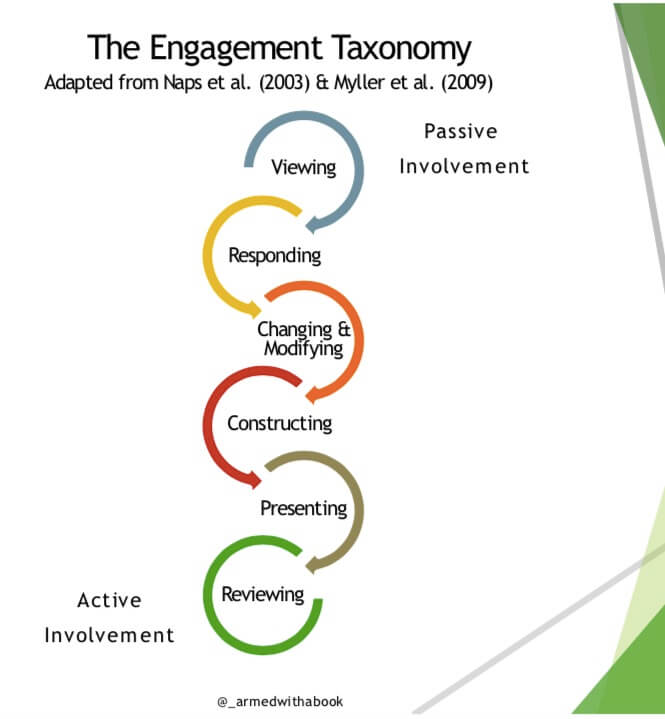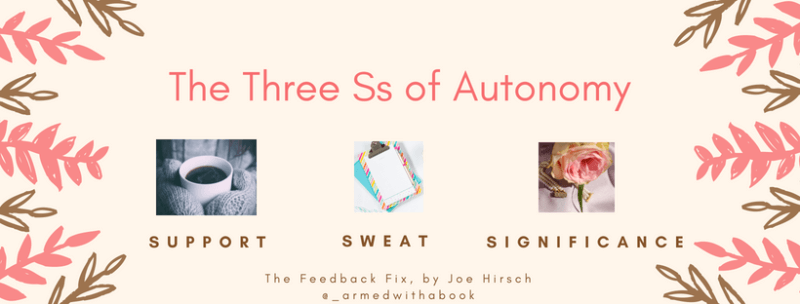I read Empower by John Spencer and AJ Juliani at the beginning of this year and it got me quite excited about a number of classroom strategies to empower my learners. As time has passed and I have read more books by educators, two questions have haunted me: first, if I create a lesson plan that engages learners, does it mean that it cannot empower them, and vice versa? And second, what are some pedagogical strategies or models that I need to be aware of to enable me to empower my learners? I explore the answers to these questions in this article.
You cannot teach the mind you cannot engage. – Carol Tomlinson
Empowered Learners
George Couros summarizes the difference between empowered and engaged learners in his book, Innovator’s Mindset. While his earlier practices in teaching were able to engage learners, giving students the opportunities to be empowered learners gave him a new perspective on the role that we play as teachers. He used the powers of differentiated instruction to empower his learners allowing them to choose from within the curriculum what they wanted to learn as well as how they wanted to present it.
I have always thought of ’empower’ and ‘engage’ as two separate words, yet, my further readings have taught me that they are actually quite interrelated. In fact, engagement leads to empowerment and empowerment, in turn, causes engagement. In Empower, the authors highlight certain aspects that empowered learners have:
- ownership of their work, due to choice in what they are learning and how they can present it.
- skills to pursue their passions, and the need to develop them further.
- the ability to build their own roadmaps, i.e., rather than following the path that is set by the teacher for all the students, they pursue their individual paths.
It all boils down to autonomy or independence. In the following section, I will explore the different levels of engagement on the Engagement Taxonomy as well as how we can keep those in mind and what we can do to make our students independent. I will also present examples from my own experiences.
The Engagement Taxonomy
As a Computer Science teacher, a book that I have found extremely helpful is Guide to Teaching Computer Science: An Activity-Based Approach by Orit Hazzan, Tami Lapidot and Noa Ragonis. It is full of pedagogical techniques that I can’t wait to explore with my students. One of the strategies that caught my eye relates directly to lesson planning. Naps et al. (2003) developed the Engagement Taxonomy for learner engagement with visualization technology and Myller et al. (2009) extended it further.
I present a more general version here that I created to apply to my lessons in Math as well. The headings are theirs’, the descriptions are mine. The degree of engagement and empowerment can be presented on a scale of passive to active involvement with the material:

The first stage, Viewing, refers to observing the materials. The recognition system of the brain as explained in the article on Universal Design for Learning recognizes the content that needs to be learned. This is possible only when the content is viewed or heard in some form. Thus, this first stage is the core action for engagement of any sort. Responding is when the learner is thinking about the material as one answers questions based on the material just learned. In the Changing & Modifying stage, the learner makes changes to the material under study, by offering alternate solutions and examples. In the Constructing stage, building of notes and artifacts takes place such that they have meaning for the learner. During presentation (Presenting stage), learners share ideas with an audience and have discussions. The last stage of Reviewing involves offering feedback, suggestions and comments on other’s work.
From the Constructing stage onwards, empowerment begins when the knowledge created and presented by the learner is based on their interests and ideas that they wanted to pursue. Presentation is also part of empowering learners: think about student conferences, where students showcase their hard work to the school community. They might not be asking for feedback always; however, they have reached that point of presenting after going through the process of feedback and acting upon it. Lastly, reviewing other students work and helping them further with suggestions and comments is another feature of empowerment. When students believe in themselves as well as in others, they help each other grow together.
Applying this to the classroom: Any activity done in class and assigned for home will be engaging and empowering if it gives the learners opportunities to pursue their interests while at the same time, develop with their peers. Some of my most memorable memories of school are about the times I worked with my peers, having discussions with them, talking out about what we had learned and reviewing each other’s work. At university level especially many a days were spent working collaboratively and checking each other’s ideas and presentations.
As a teacher, I want to give the same opportunities to my students. Some parts of the lesson will have viewing and responding components but the other parts can be at the higher stages of the Engagement Taxonomy. Here are two examples from the subjects I teach:
- My computer labs usually begin with a short tutorial in which students observe and build conceptual understanding of the topic. After that, I give them a question to work on. These are the practical applications of the concept I just taught. They are allowed to work individually and seek out help from me or their peers if need be. Once everyone has a solution, we come together as a group to talk about the different approaches taken by the students and why they make sense. When everyone agrees and no new methodologies are left to share, we move on to the next question.
- In Math, a famous technique is that of Number Talks where the students are given a problem, such as finding the number of circles on a page, or the multiplication of two numbers. They are asked to think of the solution and arrive at an answer without writing anything. Next, they have to explain their reasoning to their peers. In most examples that I have seen, the teacher draws out a visual supporting the reasoning as the student explains. I find that this exercise fits on the Engagement Taxonomy at the constructing level because students construct a solution, at the presentation level because they must explain their thinking, often clarifying it to help others understand their methodology. Review is involved here too because they are active participants in listening to others’ methodologies and class discussions.
Building Autonomy
I read The Feedback Fix by Joe Hirch recently and it made me think about the role that engagement plays in empowering learners as well the crucial part played by feedback in both these scenarios. The first part of his book focuses on fixing feedback and making it about the person receiving it rather than the person giving it. The last part of the book really got me thinking about the connections between engagement, empowerment and feedback.
A common concern that I have personally heard from my peers regarding differentiated instruction as well as with empowerment techniques such as Genius hour (check Melissa White’s article here) is that it requires them to give up control of the class time and let the learners decide what they want to do. As new teachers this can be a daunting predicament to be in because we are still developing our teaching practices and might not be as confident about classroom management. Joe reminds us that:
The secret to letting go is not what you give up. It is what you give. (p. 121)
Giving students the opportunities they need to grow and become independent can go a long way. Rather than us trying to control where their time is spent and how, whether it is listening to a lecture or completing a project we assigned, when we make the content engaging as well as ensure to present our thoughts such that students can identify their own strengths, it leads to:
- Building capacity, as we want our learners to not just know their capabilities but also be able to push boundaries.
- Increasing attention, as the Engagement Taxonomy also mentions, attention is a form of engagement and attentive students are more likely to find areas in the topic that they want to explore more in depth.
- Curbing of uncertainty in terms of what they are supposed to do and how to do it
- Restoring of confidence
By reducing uncertainty and building confidence in students, we give them the tools to continue taking ownership of their learning and growing. Joe presents three Ss of autonomy are Support, Sweat and Significance.

When supports are in place, whether in the form of the teacher or resources that would be helpful in pursuing a goal, learners feel safe to try new ideas. I used the Sticky System in my computer classes to reach the students who were not comfortable raising their hands. The subtle act of putting up a red sticky was enough to grab my attention and I would go to them to help and answer their questions. Thus, they had the supports in place to pursue their learning without worrying about the stressful parts. It can indeed be very hard to ask a question in front of the whole class.
Hardwork takes time and sweat. I love writing but for me to become a better writer, or even to call myself a writer, I have to put time and effort into it. I have to read articles, talk to people, capture the ideas that I want to explore more, do my research and then write my piece. I might reach out to my peers to review it and get feedback. When we pursue things we want to pursue that no one told us to pursue, we have to put work into them. There is no growth without effort.
When we find the things we want to pursue, that matter to us, the sweat is not a bother and the supports are welcome opportunities to develop further. When we trust the supports we have, we take the chance to find what is important to us. When we find what is important, we utilize the supports we have to the fullest.
I have autonomy in what I write and these three factors are an integral part of the writer I am. I wish the same for my students.
If autonomy is at the heart of empowerment and engagement is a spectrum, how can we make students independent while keeping them engaged?
I believe Joe has given his readers the tools to empower and engage their students. He examines three strategies that can amplify the autonomy of learners:
- Showing students that we care – when we show our students that we care about what they think and how they approach and solve problems, which might not always be how the teachers themselves approach them, we show that we respect and care for them and only wish to hone their abilities further. My sticky system showed my students that I wanted to meet them on comfortable grounds.
- Grow people, not policies – A school is a community and students are at its heart. Many factors associated with schools such as funding and budget cuts can cause negative consequences for students. However, as long as we ensure that personally, we are helping our students grow, we are making them autonomous by giving them the safe environment to nurture and experiment in.
- Knowing the needs of our students – This is paramount in helping them learn. When we relate the curriculum to their interests as well as readiness to learn and engage in new materials, we focus their attention on what we are teaching. If one of my students does not understand area and I expect him to be enthusiastic about integration (apologizes for the far-fetched example), I am not meeting his needs. Students are engaged when we meet them where they are and help them grow from there.
Applying this to the classroom: The first and third points relate closely to differentiated instruction as well because they involve knowing the students and catering learning according to their needs. I have written in depth about differentiated instruction here.

Project-Based Learning
Last, I want to touch a bit on Project-based learning. Buck Institute for Education defines it as:
Students work on a project over an extended period of time – from a week up to a semester – that engages them in solving a real-world problem or answering a complex question. They demonstrate their knowledge and skills by developing a public product or presentation for a real audience.
Project-based learning is a great way to build autonomy in student while working in a team. Since it is situated in a real-world scenario, it is more practical in nature and encourages inquiry, not just from books but also from teachers, parents and professionals. Alberta Regional Consortia offers a detailed guide on how to incorporate it in the classroom.
In computers, towards the end of the term, the students work in groups on a scenario where they apply all concepts they have learned in the course. If they have another scenario in mind, for example, instead of the airline management system, if they want to design a book store management system, I can approve their idea after review, ensuring it aligns with the project difficulty and requirements. (Autonomy as a team!) They choose the programming language they would like to present the solution in. They can create a video or give a presentation for their work. We use design thinking to ensure the teams are on the same page, doing scheduled check-ins with me and their team members.
The project generally takes a couple of weeks and usually each member of the team plays a part that he or she is comfortable with and interested in. I work with my students to keep up their excitement for the project, challenging them along the way.
Conclusion
The more I read the more ideas become holistically connected. Educators bring their unique voice and experiences to the teaching profession so it is not surprising that my attempt to understand empowerment and engagement better encompasses so many works. Rereading my own work now, I see elements of social-emotional learning as well. I hope to explore these in the future.
I hope that this article was informative and give you some ideas to think about engagement and empowerment. If you use differentiated instruction already, you are empowering your students. Of course, the sky is the limit and there is more that can be done to make them independent learners. I look forward to looking closely at my lesson plans, observing my students closely and incorporating the Engagement Taxonomy in my teaching. When I find other models, I’ll be sure to share them.
Call to Action: I encourage you to pick a lesson plan, unit or project and look at the through the lens of the Engagement Taxonomy. What stages were your students at? Thinking back about the school year that just wrapped up, what changes could you have made in your classroom to give them more autonomy in learning?
Do share your thoughts by contacting me or leaving a comment on my Medium article in A Teacher’s Hat!
References
Couros, G. (2015). The innovator’s mindset: Empower learning, unleash talent, and lead a culture of creativity. Dave Burgess Consulting, Incorporated.
Hazzan, O., Lapidot, T., & Ragonis, N. (2015). Guide to teaching computer science: An activity-based approach. Springer.
Hirsch, J. (2017). The feedback fix: Dump the past, embrace the future, and lead the way to change. Rowman & Littlefield.
Myller, N., Bednarik, R., Sutinen, E., & Ben-Ari, M. (2009). Extending the engagement taxonomy: Software visualization and collaborative learning. ACM Transactions on Computing Education (TOCE), 9(1), 7.
Naps, T. L., Rößling, G., Almstrum, V., Dann, W., Fleischer, R., Hundhausen, C., … & Velázquez-Iturbide, J. Á. (2002, June). Exploring the role of visualization and engagement in computer science education. In ACM Sigcse Bulletin (Vol. 35, No. 2, pp. 131-152). ACM.
Spencer, J., & Juliani, A.J. (2017). Empower: What happens when student own their learning. IMPress, LP.
Special thanks to Andrew Mills and Alicia Woods for their feedback.

Be First to Comment